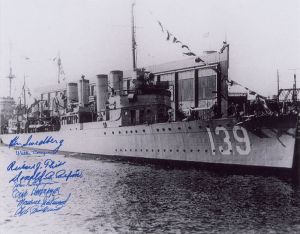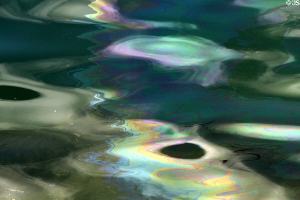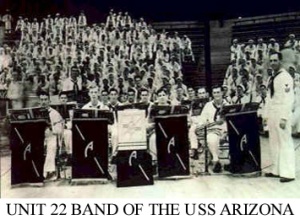Category Archives: Pearl Harbor
Six Little Known Facts about Pearl Harbor and the USS Arizona
December 7, 1941
As we commemorate the 77th anniversary of this “date which will live in infamy,” as President Franklin D. Roosevelt described it on December 8, 1941, explore six little known facts about the USS Arizona and the attack that plunged America into war.
- At 6:54 a. m. (Hawaii Time) The USS Ward sunk a Japanese midget submarine near the entrance to Pearl Harbor.
At the beginning of World War II, Captain William Outerbridge skippered the USS Ward, a re-commissioned ship built during the World War I period. Reportedly in his first command and on his first patrol off Pearl Harbor, Hawaii, on December 7, 1941, Outerbridge
beginning of World War II, Captain William Outerbridge skippered the USS Ward, a re-commissioned ship built during the World War I period. Reportedly in his first command and on his first patrol off Pearl Harbor, Hawaii, on December 7, 1941, Outerbridge and the USS Ward detected a Japanese two-man midget submarine near the entrance to Pearl Harbor. The USS Ward detected the midget sub at 6:45 AM and sank it at 6:54 AM, firing the first shots in defense of the U.S. in World War II. Captain Outerbridge was reportedly awarded the Navy Cross for Heroism.
and the USS Ward detected a Japanese two-man midget submarine near the entrance to Pearl Harbor. The USS Ward detected the midget sub at 6:45 AM and sank it at 6:54 AM, firing the first shots in defense of the U.S. in World War II. Captain Outerbridge was reportedly awarded the Navy Cross for Heroism.
(Sub was located 2002 exactly at location in Outerbridge’s report.)
- At 7:55 a.m. (Hawaii Time) – The United States of America was plunged into World War II
 At 7:55 a.m. Hawaii time (12:55 p.m. EST) on December 7, 1941, Japanese fighter planes attacked the U.S. base at Pearl Harbor, Hawaii, launching one of the deadliest attacks in American history. The assault, which lasted less than two hours, claimed the lives of more than 2,500 people, wounded 1,000 more and damaged or destroyed 18 American ships and nearly 300 airplanes. Almost half of the casualties at Pearl Harbor occurred on the naval battleship USS Arizona, which was hit four times by Japanese bombers.
At 7:55 a.m. Hawaii time (12:55 p.m. EST) on December 7, 1941, Japanese fighter planes attacked the U.S. base at Pearl Harbor, Hawaii, launching one of the deadliest attacks in American history. The assault, which lasted less than two hours, claimed the lives of more than 2,500 people, wounded 1,000 more and damaged or destroyed 18 American ships and nearly 300 airplanes. Almost half of the casualties at Pearl Harbor occurred on the naval battleship USS Arizona, which was hit four times by Japanese bombers.
- Twenty-three sets of brothers died aboard the USS Arizona.
There were 37 confirmed pairs or trios of brothers assigned to the USS Arizona on December 7, 1941. Of these 77 men, 62 were killed, and 23 sets of brothers died. Only one full set of brothers, Kenneth and Russell Warriner, survived the attack; Kenneth was away at flight school in San Diego on that day and Russell was badly wounded but recovered. Both members of the ship’s only father-and-son pair, Thomas Augusta Free and his son William Thomas Free, were killed in action. Though family members often served on the same ship before World War II, U.S. officials attempted to discourage the practice after Pearl Harbor. However, no official regulations were established, and by the end of the war hundreds of brothers had fought—and died,—together. The five Sullivan brothers of Waterloo, Iowa, for instance, jointly enlisted after learning that a friend, Bill Ball, had died aboard the USS Arizona; Their only condition upon enlistment was that they be assigned to the same ship. In November 1942, all five siblings were killed in action when their light cruiser, the USS Juneau, was sunk during the Battle of Guadalcanal in the Solomon Islands.
Almost half of the casualties at Pearl Harbor occurred on the naval battleship USS Arizona, which was hit four times by Japanese bombers and eventually sank. Among the 1,177 crewmen killed were all 21 members of the Arizona’s band, known as U.S. Navy Band Unit (NBU) 22. Most of its members were up on deck preparing to play music for the daily flag raising ceremony when the attack began. They instantly moved to man their battle positions beneath the ship’s gun turret. At no other time in American history has an entire military band died in action.
- Fuel continues to leak from the USS Arizona’s wreckage.
December 6, 1941, the USS Arizona took on a full load of fuel—nearly 1.5 million gallons—in preparation for its scheduled trip to the mainland later that month. The next day, much of it fed the explosion and subsequent fires that destroyed the ship following
its attack by Japanese bombers. While the USS Duncan was in at Pearl Harbor for refitting and repairs, Roy Boehm, a 17 year old Navy hardhat diver, was tasked with salvaging the sunken USS Arizona and diving to recover corpses and ammunition. (Boehm would continue in the Navy and eventually be asked by President John F. Kennedy to form the SEALs, thus becoming the First SEAL.)
However, despite the raging fire and ravages of time, some 500,000 gallons are still slowly seeping out of the ship’s submerged wreckage: Nearly 70 years after its demise, the USS Arizona continues to spill up to 9 quarts of oil into the harbor each day. In the mid-1990s, environmental concerns led the National Park Service (NPS) to commission a series of site studies to determine the long-term effects of the oil leakage.
 Some scientists have warned of a possible “catastrophic” eruption of oil from the wreckage, which they believe would cause extensive damage to the Hawaiian shoreline and disrupt U.S. naval functions in the area. The NPS and other governmental agencies continue to monitor the deterioration of the wreck site but are reluctant to perform extensive repairs or modifications due to the Arizona’s role as a “war grave.” In fact, the oil that often coats the surface of the water surrounding the ship has added an emotional gravity for many who visit the memorial and is sometimes referred to as the “tears of the Arizona,” or “black tears.”
Some scientists have warned of a possible “catastrophic” eruption of oil from the wreckage, which they believe would cause extensive damage to the Hawaiian shoreline and disrupt U.S. naval functions in the area. The NPS and other governmental agencies continue to monitor the deterioration of the wreck site but are reluctant to perform extensive repairs or modifications due to the Arizona’s role as a “war grave.” In fact, the oil that often coats the surface of the water surrounding the ship has added an emotional gravity for many who visit the memorial and is sometimes referred to as the “tears of the Arizona,” or “black tears.”
- Some former crew-members have chosen the USS Arizona as their final resting place.
The bonds between the crew-members of the USS Arizona have lasted far beyond the ship’s loss on December 7, 1941. Since 1982, the U.S. Navy has allowed survivors of the USS Arizona to be interred in the ship’s wreckage upon their deaths. Following a full military funeral at the Arizona memorial, the cremated remains are placed in an urn and then deposited by divers beneath one of the Arizona’s gun turrets. To date, more than 30 Arizona crewmen who survived Pearl Harbor have chosen the ship as their final resting place. Crew-members who served on the ship prior to the attack may have their ashes scattered above the wreck site, and those who served on other vessels stationed at Pearl Harbor on December 7, 1941, may have their ashes scattered above their former ships. There are 3 living survivors as of today, 02 Dec 2018. Several have decided to be buried on the Arizona.
After the USS Arizona sank, its superstructure and main armament were salvaged and reused to support the war effort, leaving its hull, two gun turrets and the remains of more than 1,000 crewmen submerged in less than 40 feet of water. In 1949 the Pacific War Memorial Commission was established to create a permanent tribute to those who had lost their lives in the attack on Pearl Harbor, but it was not until 1958 that President Dwight D. Eisenhower signed legislation to create a national memorial. The funds to build it came from both the public sector and private donors, including one unlikely source. In March 1961, entertainer Elvis Presley, who had recently finished a two-year stint in the U.S. Army, performed a benefit concert at Pearl Harbor’s Block Arena that raised over $50,000—more than 10 percent of the USS Arizona Memorial’s final cost. The monument was officially dedicated on May 30, 1962, and attracts more than 1 million visitors each year.

Recent Comments